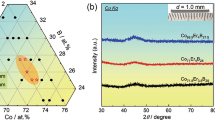Abstract
A connection has been established between the structural state (phase composition) of the nanocrystalline alloys Fe73.5 − x Co x Cu1Nb3Si13.5B9 (x = 0, 10, 20, 30) and the type of the induced magnetic anisotropy (IMA), which is formed in the process of thermomechanical treatment (TMechT), on the one hand, and its thermal stability, on the other hand. It is shown that the addition of cobalt entails a decrease in the quantity of Fe-Si grains and the formation of phases that contain Fe-Co-B. The induced magnetic anisotropy depends on the volume fractions of structural components, their elastic properties, and coherent bonding of their crystal lattices.
Similar content being viewed by others
References
N. V. Dmitrieva, V. A. Lukshina, E. G. Volkova, et al., “Induced Magnetic Anisotropy and Structure of Nanocrystalline Fe-Co-Cu-Nb-Si-B Alloys with Different Content of Co: I. Sress-Annealing Induced Magnetic Anisotropy and Its Thermal Stability,” Fiz. Met. Metalloved. 107(4), 376–382 (2009) [Phys. Met. Metallogr. 107 (4), 352–358 (2009)].
A. A. Glazer, N. M. Kleinerman, V. A. Lukshina, et al., “Thermomechanical Treatment of Nanocrystalline Fe73.5Cu1Nb3Si13.5B9 Alloy,” Fiz. Met. Metalloved., No. 12, 56–61 (1991).
G. Herzer, “Creep Induced Magnetic Anisotropy in Nanocrystalline Fe-Cu-Nb-Si-B Alloys,” IEEE Trans. Magn. 30(6), 4800–4802 (1994).
B. Hofmann and H. Kronmüller, “Stress-Induced Magnetic Anisotropy in Nanocrystalline FeCuNbSiB Alloy,” J. Magn. Magn. Mater. 152, 91–98 (1996).
M. Ohnuma, K. Hono, T. Yanai, et al., “Direct Evidence for Structural Origin of Stress-Induced Magnetic Anisotropy in Fe-Si-B-Nb-Cu Nanocrystalline Alloys,” Appl. Phys. Lett. 83(14), 2859–2861 (2003).
M. Ohnuma, K. Hono, T. Yanai, et al., “Origin of the Magnetic Anisotropy Induced by Stress Annealing in Fe-Based Nanocrystalline Alloy,” Appl. Phys. Lett. 86, 152513 (2005).
N. M. Kleinerman, V. V. Serikov, V. A. Lukshina, et al., “Induced Magnetic Anisotropy and the Structure of an FeCuNbB Nanocrystalline Alloy,” Fiz. Met. Metalloved. 98(4), 44–55 (2004) [Phys. Met. Metallogr. 98 (4), 377–388 (2004)].
V. V. Serikov, N. M. Kleinerman, E. G. Volkova, et al., “Structure and Magnetic Properties of Nanocrystalline FeCuNbSiB Alloys after a Thermomechanical Treatment,” Fiz. Met. Metalloved. 102(3), 290–295 (2006) [Phys. Met. Metallogr. 102 (3), 268–273 (2006)].
M. Ohnuma, D. H. Ping, T. Abe, et al., “Optimization of the Microstructure and Properties of Co-Substituted Fe-Si-B-Nb-Cu Nanocrystalline Soft Magnetic Alloys,” J. Appl. Phys. 93(11), 9186–9194 (2003).
G. Pavlik, P. Sovak, M. Konc, et al., “Magnetostriction and Other Properties of (Fe1 − x Cox)73.5Cu1Nb3Si13.5B9 Alloys,” J. Magn. Magn. Mater. 304(2), e681–e683 (2006).
N. I. Noskova, V. V. Shulika, and A. P. Potapov, “Magnetic Properties and Microstructure of Nanocrystalline Soft Magnetic Fe73.5 − x CoxCu1Nb3Si13.5B9 Alloys,” Fiz. Met. Metalloved. 102(5), 539–544 (2006) [Phys. Met. Metallogr. 102 (5), 506–511 (2006)].
A. Kolano-Burian, T. Kulik, G. Vlasak, et al., “Effect of Co Addition on Nanocrystallization and Soft Magnetic Properties of (Fe1 − x Cox)73.5Cu1Nb3Si13.5B9 Alloys,” J. Magn. Magn. Mater. 272–276(2), 1447–1448 (2004).
V. S. Rusakov, Mössbauer Spectroscopy of Locally Inhomogeneous Systems (Inst. Yadern. Fiz., Nat. Yadern. Tsentr Resp. Kazakhstan, Almaty, 2000).
K. Woong, K. Choo and Roy Kaplow “The Distinctness of Magnetic Hyperfine Fields Associated with Structurally Unique Iron Sites in Fe3B,” Metall. Trans. A 8(3), 417–319 (1977).
V. A. Barinov, V. A. Tsurin, V. I. Voronin, et al., “Mössbauer Investigations of the Metastable Fe23B6 Phase,” Fiz. Met. Metalloved. 101(5), 496–507 (2006) [Phys. Met. Metallogr. 101 (5), 456–466 (2006)].
Author information
Authors and Affiliations
Additional information
Original Russian Text © N.M. Kleinerman, V.V. Serikov, V.A. Lukshina, E.G. Volkova, N.V. Dmitrieva, A.P. Potapov, 2009, published in Fizika Metallov i Metallovedenie, 2009, Vol. 107, No. 5, pp. 482–489.
Rights and permissions
About this article
Cite this article
Kleinerman, N.M., Serikov, V.V., Lukshina, V.A. et al. Induced magnetic anisotropy and the structure of nanocrystalline Fe-Co-Cu-Nb-Si-B alloys with different content of Co: II structure of alloys with an induced magnetic anisotropy. Phys. Metals Metallogr. 107, 449–456 (2009). https://doi.org/10.1134/S0031918X09050056
Received:
Accepted:
Published:
Issue Date:
DOI: https://doi.org/10.1134/S0031918X09050056




